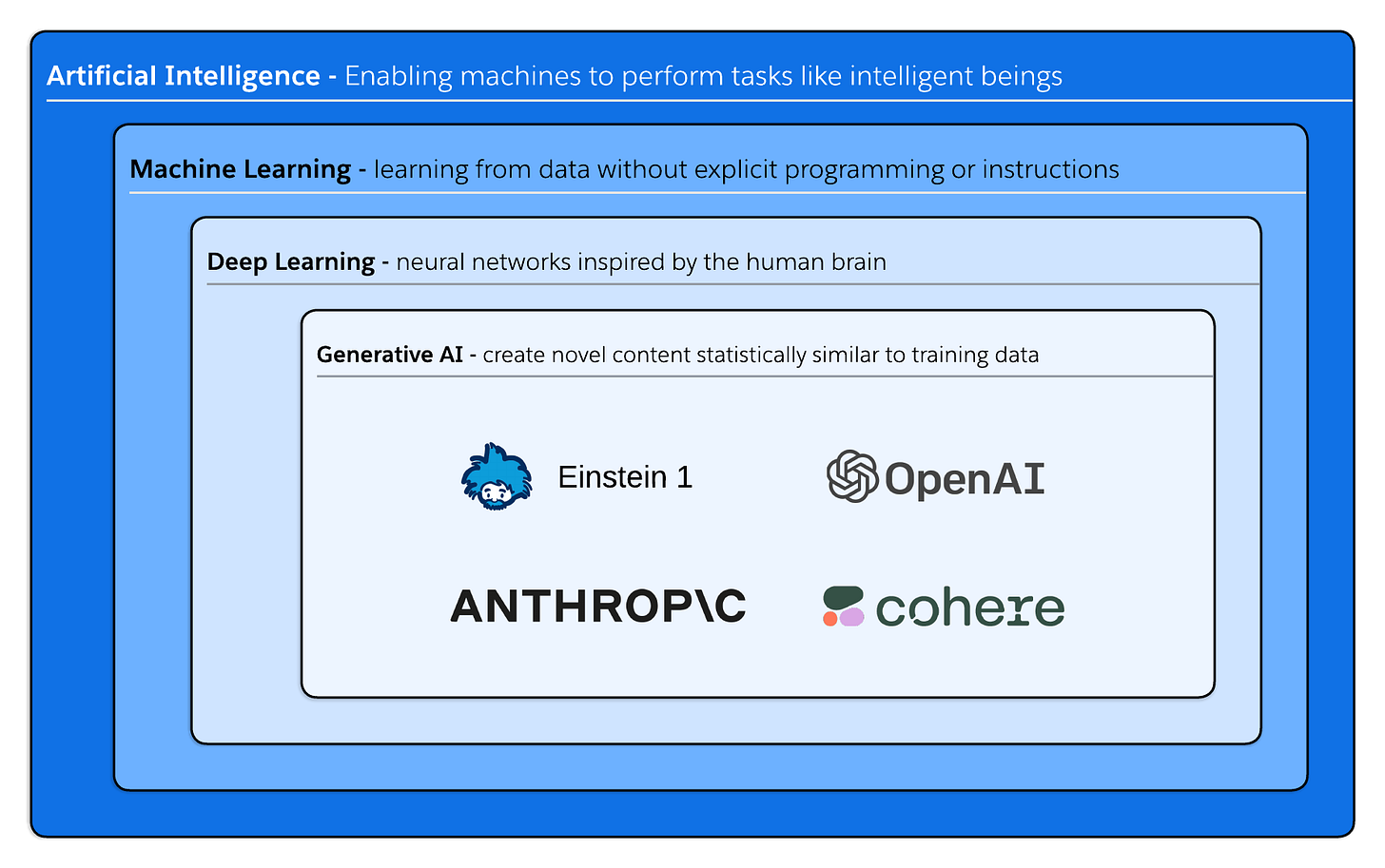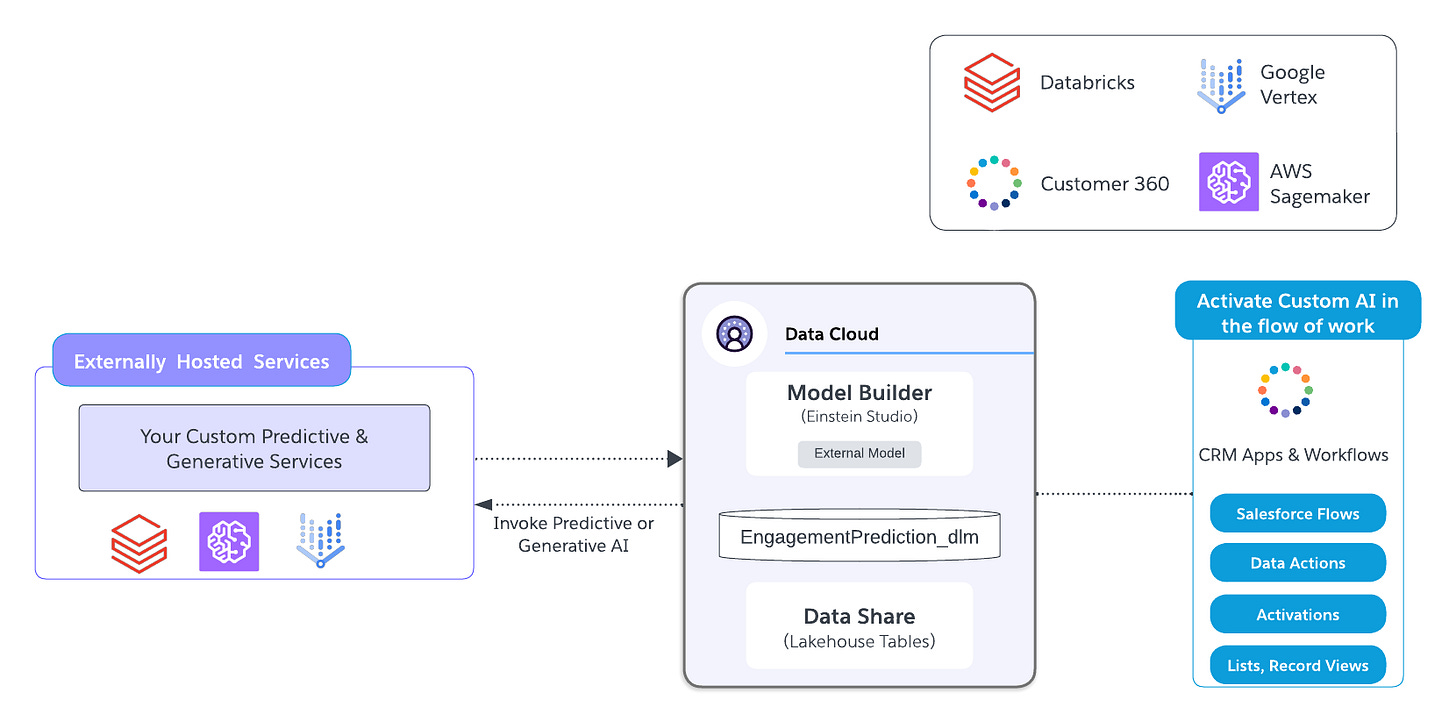A Guide To Predictive & Generative AI With Salesforce Einstein
Salesforce has been at the forefront of the AI revolution for nearly a decade, with the launch of Einstein in 2016. The platform has continuously evolved, democratising AI for CRM and empowering users across various roles. With the introduction of the new Einstein 1 platform, Salesforce is now integrating new GenAI capabilities with its existing predictive capability, all built on our integrated, trusted, automated, and open Customer 360 platform.
As a Salesforce Architect, understanding the different layers and components of AI is crucial for making informed decisions when designing solutions. This post aims to help you construct a mental model of the AI landscape and illustrate how Einstein 1 platform and tools integrate with this topology. By clearly distinguishing between Generative AI, automation, and Predictive AI, you'll be better equipped to address common customer confusion and drive value through your architectural choices.
Let’s start by taking a whistle stop tour of the AI landscape.
Understanding the Taxonomy of AI
Although rule-based expert systems were a significant part of AI's history in the 70s and 80s, the field had already been developing for decades. To really grasp the current state of AI, we'll focus on the more recent breakthroughs in Machine Learning that have revolutionised the field.
Artificial Intelligence is the broader concept of enabling a machine or system to perform tasks commonly associated with intelligent beings.
Machine Learning is an application of AI that enables systems to learn from data and improve their performance over time without being explicitly programmed.
Deep Learning is a sub-type of machine learning that uses layered networks to learn from large amounts of data, either labeled or unlabelled. It is inspired by the structure and function of the human brain, specifically the way layers of neurons in the brain process information. This biological inspiration is fundamental to the design of Artificial Neural Networks (ANNs) used in deep learning, where each layer of artificial neurons processes aspects of the data, building increasingly abstract representations.
Generative AI is a branch of AI that creates new content, like text, images, music, or video, by learning from existing data. It uses advanced deep learning techniques, particularly generative models like Generative Adversarial Networks (GANs), Variational Auto Encoders (VAEs), and Transformer-based models, to understand patterns in the data and then generates original content that mimics human creativity.
Finally a Large Language Model is a type of deep learning model that uses vast neural networks (based on Transformer architecture) with billions of parameters, and trained on large quantities of data, to understand and generate human language.
Generative AI is the latest buzz, stepping into the spotlight where machine learning and deep learning have long stood.
At this point, you might be wondering where does Predictive AI fit into this picture and how is it different from Generative AI?
Predictive vs. and Generative AI
Let’s start by broadly comparing Predictive AI with Generative AI.
Predictive AI makes predictions and prescribes actions based on what it has seen in existing data. Examples of Predictive AI are - Customer Churn Prediction, Campaign Response, Next Best Offer/Action, Lead Scoring, Case Classification, Article Recommendation, Service Analytics etc.
Salesforce has been working on Predictive AI for CRM since 2016. Einstein, today, generates over 1 trillion predictions weekly for our user base. It leverages innovations like AutoML to significantly simplify the complexities involved in integrating robust ML into production apps. Products, like Einstein Discovery, provide world-class, supervised machine learning in a fully declarative environment, and has operationalised predictions and actionable insights. Feature engineering, data sampling, training, and model management are all taken care of.
Generative AI on the other hand creates new things based on what it has learned from existing data. Examples of Generative AI are - Service Responses, Subject Lines, Work Summaries, Sales Emails, Natural Language to Code, Commerce Concierge, Chat-based Coding Assistant, Segment Creation.
What makes Einstein 1 platform so powerful for business users is that it is a hybrid AI platform that blends generative and predictive AI capabilities together with human intelligence & automation to support a variety of use cases.
Generative AI not only builds on our existing predictive AI capabilities, which already score and provide insights based on your data, but takes this a step further by not only harnessing your data for insights but also creating content, enabling you to take informed actions based on the precision that predictive AI offers.
To make this concept concrete, lets look at an example of how we blend predictive and generative AI capabilities to deliver business value.
Predictive and Generative Intelligence In the Flow of Work
As architects, we focus on business outcomes. So it’s helpful to contextualise Predictive AI and Generative AI in the context on how business users will use it. These can be captured as a series of Jobs To Be Done (JTBD) statements. This framing highlights the actions and verbs that determine the kind of AI that will help to get the job done.
Predictive AI: As a service agent, I need to pull relevant knowledge articles for a conversation.
Einstein Article Recommendations uses Predictive AI to recommend relevant knowledge articles on customer cases so agents can resolve customer inquiries more efficiently. It is trained using Natural Language Processing (NLP) that can read articles and closed cases to learn how to match them together. It’s algorithm also ranks articles based on their relevance to an open case, so Einstein only recommends highly relevant articles.
Einstein keeps learning and improving the predictive capabilities of Article Recommendations as you use attach articles to cases, expand your knowledge base, update your case fields, and regularly review the model scorecard.
Generative AI: As a service agent, I need to summarise conversations to create knowledge articles.
Work Summaries saves agents time by creating AI-generated Case summaries. Einstein analyses chat interactions between service agents and customers to predict and fill summaries, issues, and resolutions. Agents can then review, edit, and save these summaries. Work Summaries are powered by the summarisation capabilities of Generative AI.
Predictive AI + Generative AI: As a service agent, I need to craft responses to customer inquiries in a way that's informed by company knowledge.
Service Replies feature can generate replies during a customer chat. It can also draft and send emails based on recommended Knowledge articles, directly from the Case page. This combines both Predictive AI capability of recommended Knowledge articles, with Generative AI’s capability of Service Replies.
The Predictive + Generative AI jobs above are not simply limited to the LLMs that Salesforce provides. Einstein 1 also provides the ability to Bring Your Own Model (BYOM) and Bring Your Own LLM (BYO-LLM). For more complex use case like Fraud Detection, or Sentiment Analysis of Customer Interactions, your organization can use the data stored in Salesforce to train a model on a machine learning platform of your choice like Databricks, AWS Sagemaker, or Google Vertex, and then connect this model with Salesforce to consume the inferences or predictions and insights in various workflows across Salesforce, or maybe you also want to use a LLM hosted on the customers AI cloud infrastructure for Generative use cases.
Enter Bring Your Own Model (BYOM) and Bring Your Own LLM (BYO-LLM) capability of Einstein Studio using Data Cloud and Model Builder.
With BYOM and BYO-LLM, architects can significantly improve the ROI on the investment that their customers have made in their own Machine Learning infrastructure and most importantly make the outcomes accessible to business users who need it in CRM in the flow of work.
Conclusion
From the early days of Predictive ML based offerings to the recent introduction of the Einstein 1 platform with the latest Copilot conversational AI assistant, Salesforce has consistently pushed the boundaries of what’s possible, integrating AI into the fabric of CRM and making it available in the flow of work. By understanding how the blend of predictive and generative capabilities of the Einstein 1 hybrid AI platform, Salesforce Architects can help drive desired outcomes for their customers.



